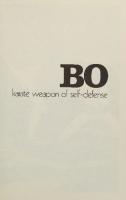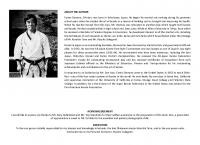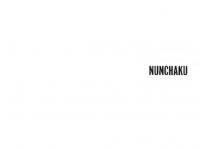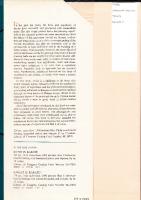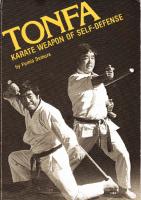TONFA: Karate Weapon of Self-Defense 0897500806, 9780897500807
In this fully illustrated book, Fumio Demura explores the full range of tonfa tactics including stances, karate and tonf
129 60 11MB
English Pages 148 Year 1982
Recommend Papers
File loading please wait...
Citation preview
u.s.
$13.95
LITERAR.Y I-INKS TO TI{E OR.IENIT
IDEALS OF THE SAMURAT: v of t a t d h v *, - i i,), iirl),11,ti1*'
ii
t t d n.\
r"o...'e
lryarriors
t_2-J of Tae Kwon Do Hyutrs r.1_LGU^E Dv Kim pyunq S.a (113, TAN-cUN AND TO_SAN ofTae Rwon Do HYung fi ov rh,'on Rhrt tlf,6 TH€ WE4,PONLESS WARRIORS WON-HYO AND YUL_KOK of. fae Kwon Do H) ung u.v (ru (.j13, Dv Jhonn Rh"c I lO7 ^t..n.trd ) BUSHIDO: The Warrior,s Code CH-UN-GUN and TO|_GyE of T re Xwon Do Hlung D\'tna:o Nitobt t30-3t D) rha,'n Rhe" tl{,g) BUDOSHOSHINSHU: The p.i-.. of D.idoji yuzrn HW-A-RANG and CHUNG-MtJ n Warr ttdn-\tdcd hv w,tr,"_ s,,i,i.iyiii).,io.L or-rh,ton Rhec tlog) 'fTae Kwoh Do Hlung JUJITSU: Bash Tect Do (Moo Duk Kwan, vot. I o| ucorgc Kirhy t12sl riqr". oi tt " Genlle Art LlP. TwgLChun Dy Kt(hdrd tt20) iy*'#-'"'ll,:T2:liaie rechniques or rhe Genrre Arr InLKt.hard T*91. tMoo Duk Ksan.) vor. 2 Dy "
[r.,""#[:li##:""3*i:.",,,
SMALL.CIRCLE .IU-IITSI Walh Ja\ t462J
f ''it : : :,tri: r: :K
ITI;?3:
ffl1',1
i
D., :
i"'
or
Chun "o 1422, ;iP""3,YtJX1['J Formsorrae Kwon
I
h\
Ja pan
*e A rt
ff":#r(rffl;ff
or serr- Derense
DEVELoP cHr PowER
Igy.To n.t wtilrdm Cheunk t4SOl
CHINESE GUNG FTI by Bruce ke (4St) TAO OF JEET KUNE DO
D)/ANCED EXPLOSI VE Kr(.Ks L
h,,n8 k( tl33) iD]/ANCFp DYNAMrc KlcKs
ht
::.y:,',*" SUPJR DYNAMIC KTCKS p\ h,,nX
I?c l409t
tl27t
FoR coMBAr :lltr_< Fr.qHIrNG D. L.heni.\
or srick Fighting
t
bv
of Self_Defense
Self-Defense
. anu,, uenturd lt24t {: Karate Wealnn of SelfOcfense JO.\l . r !t.t,t D(murd \4171
\ \:E-D ToNFA:.Japanese weapon of setf-Defense -{D} . _i.. \ h t n nltt.ht td t4s6t hL \G Ff DRAGON POLE t
(44j\
--" !T,r.*;1ln!"G. tN KUNc F.U AND KARATE 39,;,^G GAR KUNG FU 1".:- ,.,":i+fl:;";J*fi .a K)nP 14241 FoR louNG PEOPLE lt)"_T ,,,,,tn,j f runA Hiil t4t6) .AJ\ {t\ {\ GOJU.RYU: Funda mentals ofshorei-Kan - . - t .!!, ht tl2tt
: .,-':1, -.-l iliroF
oKTNAWAN KARATE
.]\\I\(., IO( R\AMENT XARATE .. .. -. , tl2ll tr6Lf\\I\G I\ARATE 1-
i. :t.).rrrrleodx.
l,
1* ' ;f .*io"lilJf,lJl'r
pracricat Appticarion
R we't t2tot
Lee ,tnd
i
r;;;;;i;ifi'u"n*4:Adwroed'nt
ffii,,ig.x:,Y1frtr,8tr r: WING CHUN XUnC rU, Ct i,"Arl
BOr tiarate Wea[Er ofself-Defense
Cheuns
am,,
A
Karale
se of Self-Defense rilm".\ nmm bc l1og) ADVANCED WING CHI,IN b| Wiltiilm Cheunp t4S7t NINJA: The Jnvisible Assassins n\ Andre\ Addms (3021 NINJA,VOL. l: Spirit of the Shadow lvarrior n\, stephen K. Hdv_\ t4ll t warrior ways of Entishrenmenr If XIl,vo!. ?: n\'Jtephen K. Ha|et t4l4l path o[.rbkasure I,lLn,"o!. i: warrior o| stcphen K Ha\e\ t4271 Ni ght warrior
i ilii,""?2 i; :i;j;''n' "i:
Lore of rhe shinobi warrior Itf1.1,]"!.i, Ft rt"phen K. H.tves 14631
VIDEOS FRC)M publrc arrcrNs. I NC S.t,rLB_ow
iriqf"i"ifihff fl tt^x",'H3il""J;:i:i*:*rux" KARATE (Shiro_Rvu
miru
cmparis' vo,,*
n-\
\L\CHAKU
S-{l: Karate Weapon of . runt,, Dcmurd \tl'l
1446)
rntrcn l .m5 516gp16
JO: Art of lhe Japanese Short Staff ,,\ uutc u,q,n (4isl Arr of the Japanese sword P.OI(KEl\: .\ u,t\ c Lt^ 1443) ^ Dt \AMIC NUNCHAKU h\ t,ltttr\ht ytmd.\htt.t (4451 {D-\,{NCED NUNCHAKU !, !-"i1.' o,a,,,, .,nd Diln tv, h t t 26)
IN ACTION t. tt,terh C. H"1.r (42f ) \( Karate lveapon .\CHAI(U: -. tuml, D(murtttttll
FIG HTER
l,s"r.h"T.dut+E h\ Bru.? L"c ,tnd M. uyaa,ui;;f;pvtu '1*r*nBRUCE LEE'S FIGHTINC ME'I u"tu-t Bffic Trainins h\^arucc t?e ,n.r M. uv"hara,oblfo'' ': BRUCE I.EE'S I:IGHTING METH va**'lt skir in Tittuiqrc b \ B r tu ( t4 . n.l M. r.t \ c h a ra, ibolD' " MS FICHTNG A,GI]{C PRVCE I
tt30,
;'l?:-Ti.lLI1?:
l?p l40l)
THE LEGENDARY BRUCE LEE A_th( cditot \ ,,[ Btd, A BA m,tao!in( THE BRUCE LEE STORY b.r Linda I4e t46O) DEAR BRUCE LEE br Ohara pubti(ations, In.. t4O7t
TH^E (.oMPLETE ART h\ KtLh.trd Bvrne \434, OF BREAKTNC STIF:DPFENSE For{ (.oMaAT JN.1Ig ,,\ t,tt(ndet D. L(hunis
rhe Firipino Ail
Bru,.c
[rfr Y:;X: A:iBLE
Chuns nn.t C.rnthtrt R,ilhrt\ L t444)
L
Appricartun
Dv
KICKING TECHNIOUES h\ K,,\,Kurhon t2llt ..{
irs
TAI CHt CHUAN: The 27 Forms Matihail Ho o l44g)
s.rr-D"r.,."
DY,\AMIC KTCKS: n\ L h()nx Lce tlZ2) Essentials for Fre Fi8hting
r\
Do
Phil@p*lv orYm a'd Yills and
I
KtcKING TrcuNrorrps
xeUursuxar ,qrxioo"
rsBN O_89750_080_6
r
TONEA Karate Weapon of Self'Defense by Fumio Demura
Edited by Gregory Lee Graphic Design by Karen Massad
OOhara Publications, lncorporated 1982
All rights reserved Printed in the United States of America Library of Congress, Catalog Card No. 82-81S57 ISBN No.0-89750-080-6 '
Eighteenlh printing I 998
WARNING This book is presented only as a means of preserving a unique aspect of the heritage of the martial arts. Neither Ohara Publications nor the author makes any representation, warranty or guarantee that the techniques described or illustrated in this book will be safe or effective in any self-defense situation or otherwise. You may be injured if you apply or train in the techniques illustrated in this book. To minimize the risk of training injury, nothing described or illustrated in this book should be undertaken without personal, expert instruction. In addition, it is essential that you consult a physician regarding whether or not to attempt anything desEribed in this book. Federal, state or local law may prohibit the use or possession of any of the weapons described or illustrated in this book. Specific self-defense responses illustrated in this book may not be justified in any particular situation in view of all of the circumstances or under the applicable federal, state or local law. Neither Ohara Publications nor the author makes any representation or warranty regarding the legality or appropriateness of any weapon or technique mentioned in this book.
oHARA
lp
euaLlcAloNS, tNcoRPoRATED
SANTA CLARITA, CALIFORNIA
ACKNOWLEDGEMENTS I would like to express my thanks to Gladys Caldwell and Dwight Lomayasva for their_help in the preparation of this book; and to my excellent students, chuck Lanza and Kiyoshi Kusuhara for their assistance as my partners in the photographs. My appreciation also to the staff of Ohara Publications.
DEDICATION
To the late Okinawan karate and kobudo master, Kenshin Taira, that perfect example of the gentle spirit of the martial arts, who was initially responsible for my interest and subsequent skill in kobudo; to Ryusho Sakagami and Kenwa Mabuni, revered masters who'are the founders of modern kobudo and karate; and to Masu Demura, my honored mother, for her constant mental inspiration.
ABOUT THE AUTHOR umio Demura, fifth-dan, is one of the most highly respected karateka in the world today. His strenuous schedule of demonstrdtions has made him an ambassador in the world of karate, taking him frohr Europe and dhe Middle East to Central America and Australia. Born in Yokohama, Japan, Demura first studied kendo in grammar school, progressing during his school years from karate and aikido to judo. While at Nihon University in Tokyo, he earned a Bachelor of Science degree in economics. At the same time, he developed his special interest in Robudo, including the use of such weaPons as the bo, the sai, the nunchaku, the tonfa and the kama. Demura studied kobudo under the tutelage of Kenshin Taira and Ryusho Sakagami. His reputation as a champion was secured in 1961 when he won the All-Japan Karate Freestyle Tournament, and for three consecutive years thereafter he was rated as one of Japan's top eight competitors. His many tournament wins include the East Japan, the Shito'Ryu Annual and the Kanto District championships. Demura has also'received the All-Japan Karate Federation President's trophy for outstanding tournament play, and he has been awarded certificates of recognition from Japanese Cabinet officials for his contributions to the art of karate. In 1965, Demura came to the United States at the invitation of Dan
Ivan to teach Shito-Ryu, one of the world's four major systems of karate.
Demura has entertained and educated thousands of people since 1968 at such diverse places as the Japanese Village and Deer Park in Buena Park, California; Marineland; Disneyland; the Las Vegas Hilton; and even the Playboy Club in New York City. He has appeared as a stunt man in films, ihcluding The lsland of Dr. Moreau. BLACK BELI Magazine's Hall of Fame has twice honored Fumio Demura, once in 1969 when he was named Karate Sensei of the Year and in 1975 when he was honored as Martial Artist of the Year. He has also won the martial arts' Golden Fist Award (1973) Since 7970, Demura has authored five books, beginning with ShitoRgu Karate. His books on kobudo include Nunchaku(7971), Sai (7974), Bo (1976) and Aduanced Nunchaku with Dan lvan (1977).
,
HISTORY uring the 17th century, the people of Okinawa were Prohibited from using weapons such as knives, swords and spears by the invading government of Japan. The lack of workable metal in the Ryukyu Islands added to the scarcity of weapons in Okinawa. This condition, and the need for personal protection, stimulated the development of the Okinawan martial arts: karate and kobudo.
Most kobudo webpons' were originally farm implements, in' geniously converted into effective weaPons of self-defense. The nun' chaku, the bo and the tonfa are three examples. The nunchaku, constructed of two hardwood sticks secured together at one end by a braided rope, could be used either to pound grain or to strike, block and pinch. The bo may originally have been the tenbin, a staff used to carry buckets of water on the shoulders. It's use as a powerful striking and blocking weapon with greater reach is obvious. The tonfa, or toifa (handle), was originally a wooden handle fitted into a hole on the side of a millstone used by the Okinawans for milling grain. This handle, which was easily disengaged from the millstone, became a very effective weapon of defense. The main part of the tonfa, or millstone handle, consists of a largle hardwood body about 15 to 20 inches in length and a smaller cylindrical grip secured at a right angle to the main body about six inches from one end. The early practitioners of the Okinawan rnartial arts foresaw these weapons as an extension of their hand techniques, and quickly adopted these weapons into their training. Karate and kobudo are mutually supportive practices; the knowledge of both skills can improve the student's techniques immensely. Without a thorough knowledge of karate basics, the tonfa student is severely limited in his development. By the same token, improvement in the use of the tonfa extends the attacks and strengthens the blocks of the karate student. Continued practice with the tonfa can hclp improve balance, coordination and physical strength.
CONTENTS Chapter l: INTRODUCTION TOTHETONFA.
.
. . .11
.....17
Chapterll:TONFASTANCES Chapter lll: KARATF AND TONFA SIMILARITIES Chapter lV: TONFA STRIKING TECHNIQUES.
.
.
. . , .27 . .49
ChapterV:SELF-DEFENSEAPPLICATIONS . . . . . . . .81
ffi +t*fi *+.+
++*
ffi ;li,l,,',.,.,i
l
i
l
ll
W
Chapter
I
INTRODUCTION TO THE TONFA hough not as ftasfry or as glamorous as the nunchaku, the tonfa is nevertheless an important tool in the kobudo tradition. Two tonfa in the hands of an expert make a poetic and graceful contribution to the art of kata. The tonfa is also an excellent tool for the development of stronger hands and wrists, essential for achieving necessary Power in blocking and striking in empty-hand techniques. This is where the tonfa is par' ticularly desirable in practice over such weaPons as the bo or nunchaku. Swinging the tonfa requires a snap of the wrist not unlike that used in the last instant of a karate punch. By developing control-for instance, learning to stop the swivel motion of the tonfa by gripping.the handle harder-hand strength will improve rapidly. ln this section, a basic introduction to the tonfa is provided. It is recommended that a karate student not begin practice with this or other kobudo implements until he or she has had at least seVeral y()ars of karate training.
ANATOMY OF THE TONFA In order to deliver or receive a powerful blow, the parts of the tonfa must be strong, yet flexible. Several hardwoods which are not too brittle will satisfy this requirement, with the most popular materials being oak and cherry wood. Grip Head
Back Head
Front Head
The length of the tonfa is determined from the grip to the back
head. While holding the tonfa, the back head should extend past the
elbow by about one-half inch. Once this distance is determined, the balance of the tonfa can be adjusted by reducing the length from the grip to the front head. Under these requirements, one must choose a length and balance to fit his physical characteristics and strength.
CARE OF THE TONFA Normally, the tonfa is made of oak and consequently is very sturdy,
but the connection between the grip and the main body can be a source of weakness. This location should always be checked before each practice to prevent injuries. The tonfa can also be varnished, if desired, and should be cleaned periodically with a cloth moistened
with olive or other vegetable oil.
TYPES OF TONFA Though the basic configuration of all tonfa is the same, with the small grip attached near one end of the weapon, the main body of the tonfa can be found in varied shapes. The illustrations below show some of the more common ones.
The square tonfa has four diStinct faces on the main body, forming a long rectangle.
The top edge of the main body in this tonfa is flat, while the sides and bottom are rounded, forming a semicircle. This is the most popular tonfa shaPe.
The main body of this tonfa is completely round from end-to-end.
A crude, pointed tonfa with both back and front heads ending in a point which can be used for stabbing defenses.
A pacldle-shaped tonfa, with the back troacl considerably wider
Itoittl.
than the front
The portion of the main body attaclrcd below the grip is wider and flatter than the rest of the bodY, which is round.
GRIPPING THE TONFA The grasp of the tonfa resembles the karate fist. The grip is held loosely, yet firm enough so that the weapon is not dropped while in use. This somewhat loose hold allows the tonfa grip to move easily in the palm of the hand. At the moment of a strike or block one should squeeze or tighten the fingers around the tonfa grip to form a tight fist. To be effective with the weapon, the practitioner should develop
THE GRASP Place the grip of the tonfa (1) between
the thumb and the index finger.
(2)
Place the palm of the hand on the grip. (3) Close the fingers over the grip. (4) Be sure the thumb is on top of the in-
dex finger, as
if
making
a fist.
(5)
Touch the top of the tonfa, back head end, to the elbow. (6) Front view of the tonfa adjusted correctly to the elbow.
strength in his wrist. This development will aid in the practitioner's karate training. When swinging the tonfa it is critical to remember that minimal bending of the elbow is absolutely essential to avoid striking yourself with the weapon. Great care must be taken to keep the arms extended when rotating the tonfa.
.,iitriiii!i :r:iii:iil!:
Chapter ll
TONFA STANCES he stances reviewbd in this chapter are identical to those used in karate. Proper balance and maintaining good hip position is as essential in kobudo practice with the.tonfa as. in karate. Some of the stances, such as the heiko'dachi, kiba'dachi Other and, zenkutsu-dachr, will be familiar to students of karate' they because omitted been have stances, for example, the T'dachi, tonfa. with the in use have limited practical application Any stance should never be thought of as a decoration, but foundation for an effective, strong defense'
I
ii 'iiiii,
HEISOKU.DACHI
(Attention Stance)
A ready position in which your feet are together and
liil
arms at your sides. This
stance places the student in a proper position from
which to bow. iii
lrl tlr
1i
tl
llrl
MUSUBI.DACH!
rlil
(Attention Stancefeet out)
Iii
your heels are together
rll
A ready position in which
and toes pointed outward forming right angles. Your arms are slightly forward, gripping the tonfa.
HE!KO.DACHI (Open Parallel Stance).
A natural position" in which your feet are sPread slightlY apart approximatelY shoulder width, with the toes pointed forward.
SOTO-HACHIJ!.DACHI
(Outward Open Leg Stance) A natural position similar to ttrc heiko-dachi, excePt that
toes are pointed out'
UCHI.HACHIJI.DACHI (lnverted Open Leg Stance)
The heels are
separated
about shoulder width and the feet are turned inward at a 4S-degree angle.
SANCHIN.DACH! (Hourglass Stance)
An inside, tensed stance in which your legs are spread slightly apart about shoul-
der width with the
toes
pointed inward. One foot should be placed slightly forward so that the heel of
the forward foot is in line with the toes of the back foot.
REI.NO.JI.DACHI (V-Stance) The front foot is placed half
and" in line with the back foot. The toes of the front foot are pointed straight ahead while the
a step ahead
toes of the back foot are angled 45-degrees out.
KIBA.DACHI
(Horse Riding Stance) Ihe toes are turned inward, krrees bent, and the hiPs lhrust forward, pushing the krwer stomach area to the lrorrt.
SHIKO.DACHI
(Square Stance)
This stance is almost the same as the kiba-dachi or horse riding stance except that the feet are turned out-
ward at a 4S-degree angle and the hips are dropped lower.
ZENKUTSU.DACHI
(Forward Stance) This forward stance is wide-
ly used with attacks.
Put
most of your weight on your front leg while your back leg pushes forward. The shoulders remain squared.
llr I
I
GYAKU.ZENKUTSU.DACHI
(Rear Defense Stance)
This stance is used to retreat from attack from the
rear. Weight distribution and foot positions are the same as in the zenkutsudachi or forward stance.
KOKUTSU.DACHI
(Back Stance)
This stance is used to
fend against a frontal lack. Put most of your weight on your rear leg so that it may be used for suP1rort. The front foot points
:;traight ahead, the back kxrt angled out at 90r
k r
